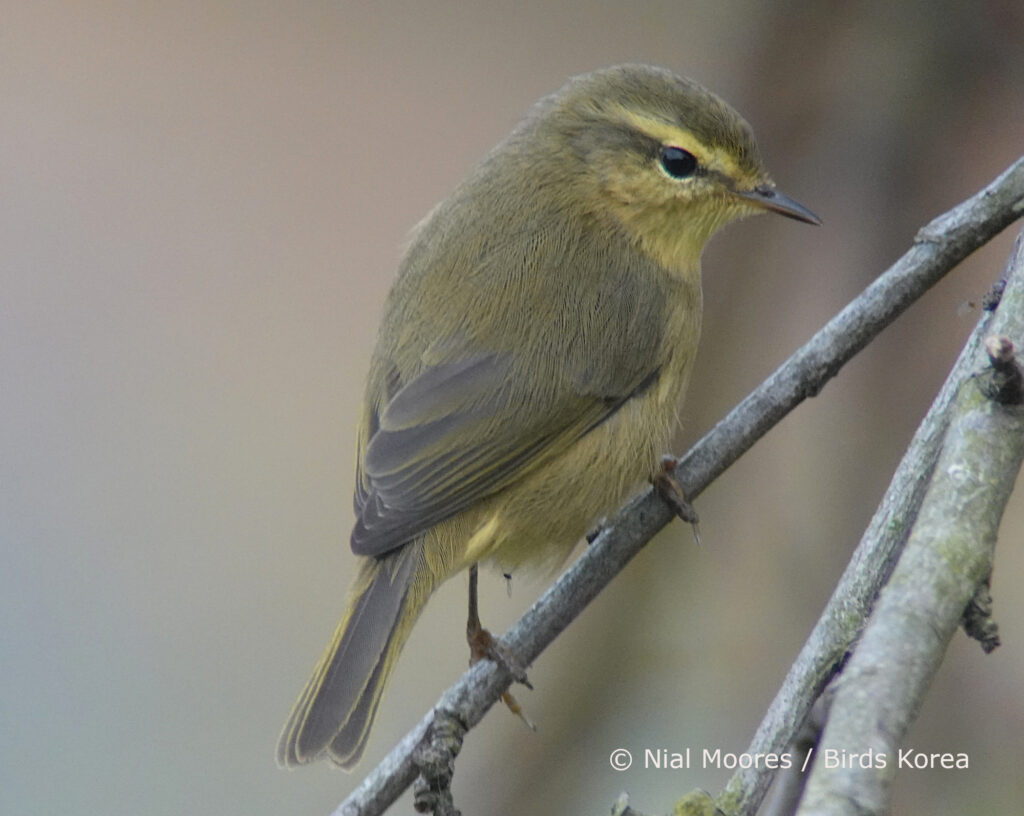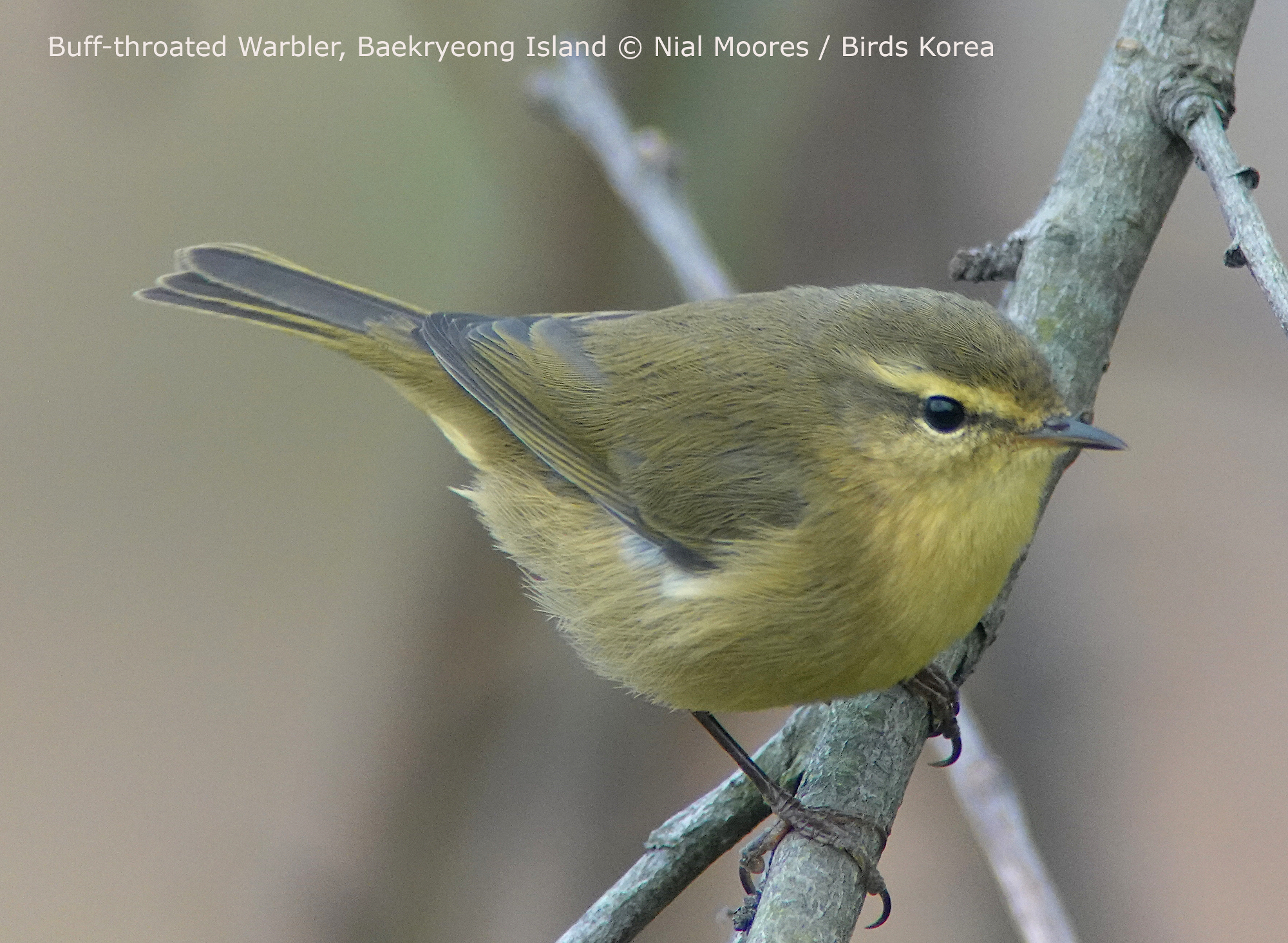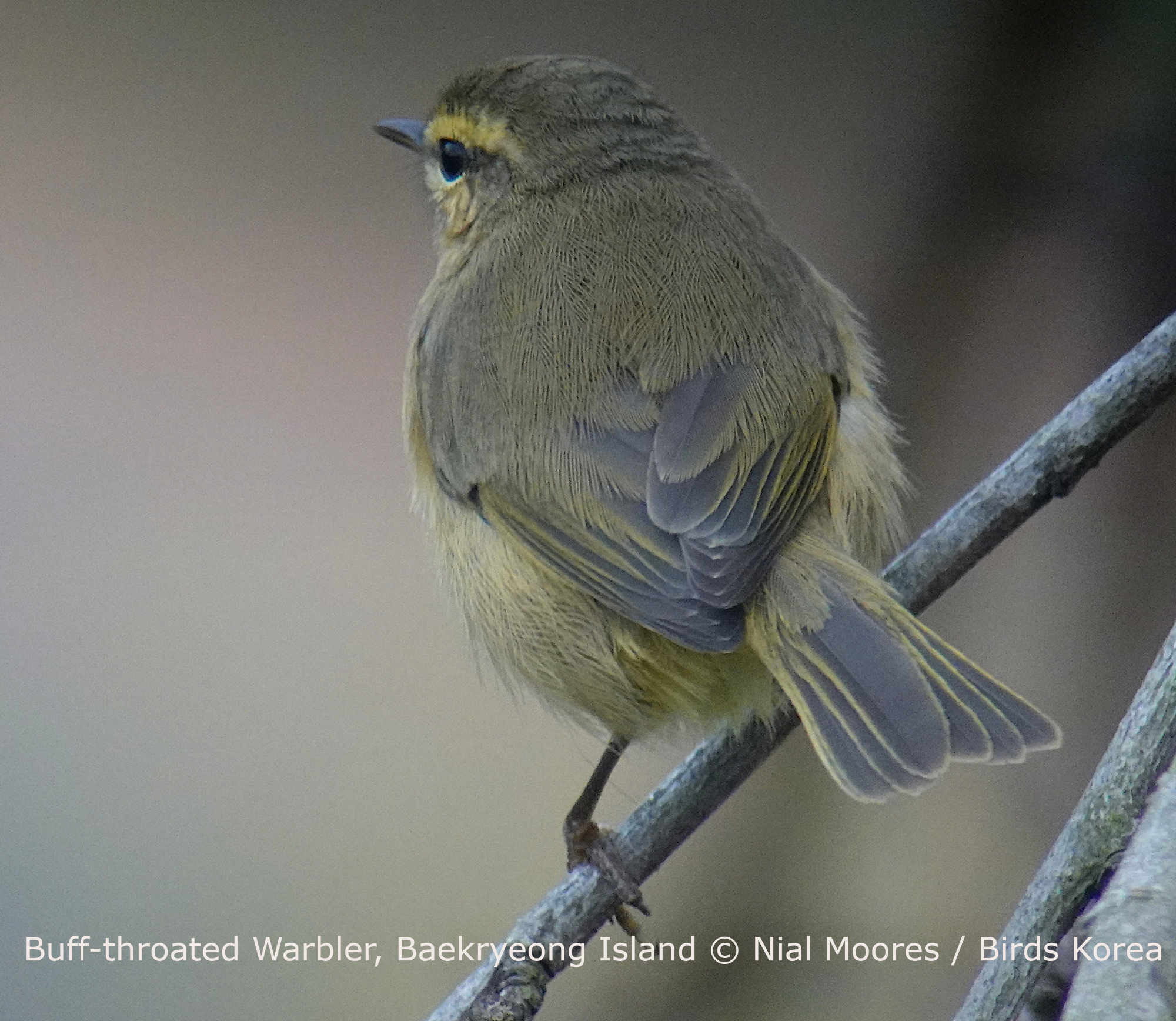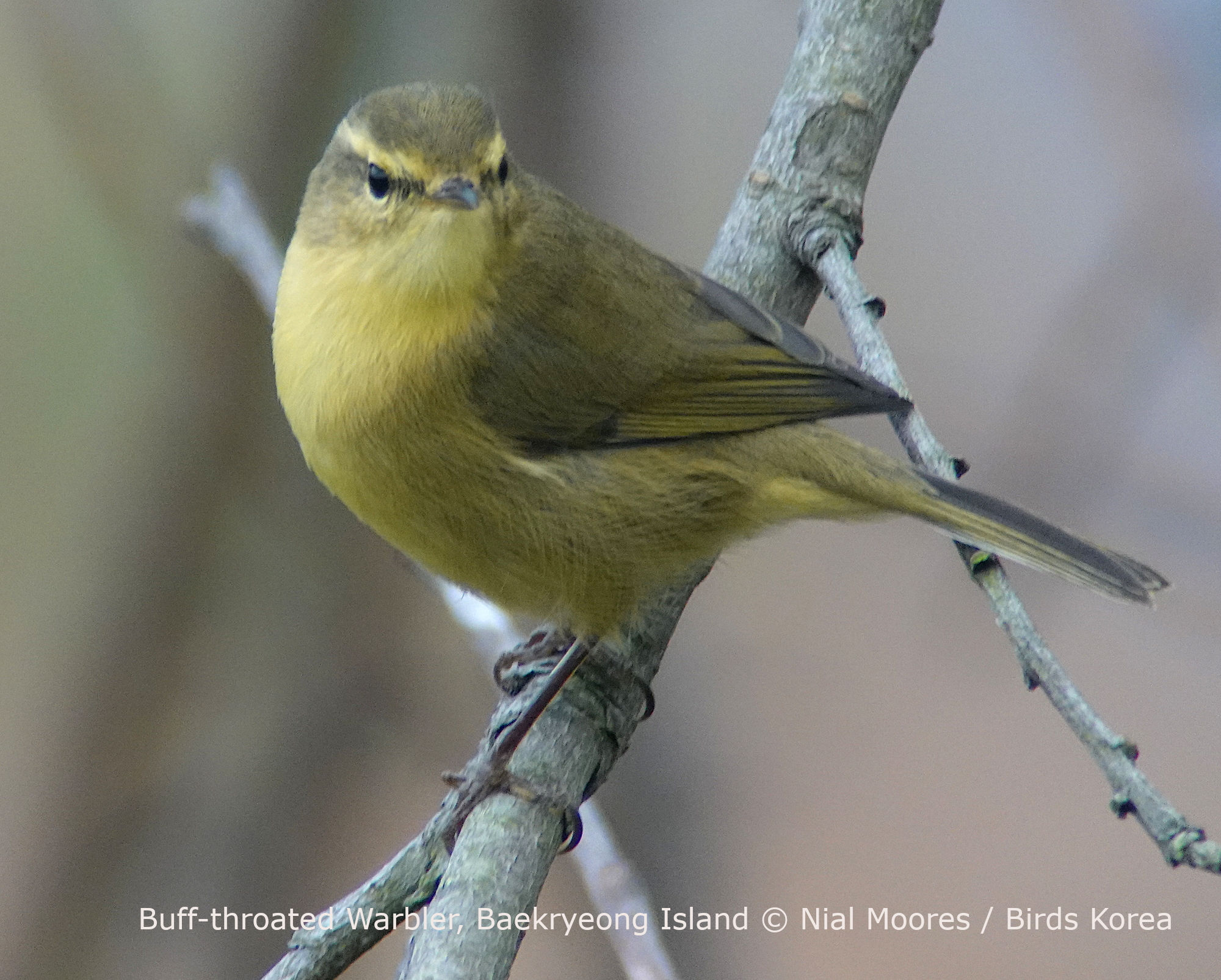Nial Moores, November 7th 2020

On October 31st 2020, while conducting bird survey on biodiversity hotspot Baekryeong Island, Incheon, as part of the Birds Korea Baekryeong Wetlands Project, I heard an unfamiliar and incessant “Prrip-Priip” call. This initially suggested one of the call types of Red Crossbill Loxia curvirostra, being given distantly. However, a movement close-by revealed soon after that this call was instead being given by a leaf warbler, foraging close to the ground in dense grasses and low bushes.
Staying largely hidden, the bird looked similar in size to and behaved like a Dusky Warbler Phylloscopus fuscatus, but was substantially brighter-looking, with yellowish tones to the breast contrasting with brownish flanks and belly, a greenish blaze across the remiges, and green edges to otherwise very dark-looking tail feathers. The legs were dark, almost black, and the bill was largely dark, with orange confined to the basal quarter or fifth of the lower mandible. The freshness of the plumage (and the shape of the tail feathers) suggested this was likely a juvenile. But a juvenile what?

The lack of either wing bars or a median crown stripe and the brightness of the breast combined with the otherwise brown-washed underparts ruled out 19 of the 20 species of Phylloscopus Leaf Warbler already recorded in Korea, leaving only Alpine Leaf Warbler P. occisinensis (this in the assumption that the extremely similar-looking Tickell’s Leaf Warbler P. affinis of the Himalayas has yet to be recorded here). Or if not, a national first record.


All nine or so of the Alpine Leaf Warblers I have heard and seen in the ROK since the first on Socheong back in 2005 (Moores 2007), including the most recent ones on Baekryeong, were worn adults, with pinkish or pinkish-brown legs and dark on the lower mandible that was confined to the tip or the distal third of the bill. In addition, all showed a less contrasting face pattern than this bird, with paler, mottled-with-yellow ear-coverts, and more extensive and cleaner yellow on the underparts, in at least several faintly tinged orange on the breast (one of the very few diagnostic plumage features separating Alpine from Tickell’s Leaf: Martens et al. 2008). The calls also sounded markedly differently. All the Alpine Leaf I have heard gave quite simple, clean sparrow-like “Chep” calls. Although very quick, this call was more complex, with two main parts, linked by a slightly rolling “rr” sound. Identification as Alpine Leaf Warbler of this bird therefore seemed highly implausible.
If not an Alpine Leaf in an odd plumage with an aberrant call, then how to rule out (or to rule in) three species which are described as being morphologically very similar to Alpine Leaf and to each other: Tickell’s Leaf Warbler; Sulphur-bellied Warbler P. griseolus; and Buff-throated Warbler P. subaffinis?
So similar-looking are these species said to be that Alpine Leaf Warbler has been described by Prof. Per Alström as “almost identical to Tickell’s Leaf” (see here). In addition, Alpine Leaf seems still not to have been split from Tickell’s Leaf by BirdLife International (2020), despite differences in molecular genetics and bioacoustics (Martens et al. 2008), which long ago led to this species’ inclusion in the IOC Checklist (Gill et al. 2020). Addressing other species in this group, Alström and Olsson (1994) also wrote ominously in their ground-breaking ID paper that, “Tickell’s and Buff-throated are very similar and no single morphological character is diagnostic”. However, as with so many of these challenging species, and as these authors attest, vocalisations are much the easiest way to make a firm identification.
Knowing this, the first few seconds of the encounter were followed by a prolonged state of patient panic, of excitement and of dread. The bird was mobile and elusive. Five seconds of calls were followed by minutes of silence. The afternoon sky started to darken and the first rain drops started to fall, and I had failed to make any sound recordings on my phone or to take any digiscoped images. One time the bird perched up but was immediately flushed by a smiling nun as she passed me by, wishing to exchange greetings. After 90 long minutes, I finally managed to make some poor recordings through my aging Samsung 5.0.1 smart-phone, and once these were secured, I also took a series of digi-scoped images – mostly as the bird sat up prominently for the first and last time in a small sapling. What a gorgeous-looking bird!
The images confirm the features noted in the field, including the extent of dark on the bill; and once the pressure to document the bird had lifted, I could walk away and compare the recordings on my phone with recordings of Buff-throated Warbler on the indispensable Xeno-Canto website. To my ears, they were an obvious match.
In under an hour I was back at the excellent Munhwa motel, using FB to share one of the sound recordings and one of the images with two top field workers based in SE Asia: Prof. Phil Round and Nick Upton. Both responded immediately in support of my tentative ID of the bird as a Buff-throated Warbler (sincere thanks to both!). Prof. Round messaged that the image combined with a description of the call, meant that the bird, “looks like an unassailable Buff-throated”; and Nick Upton, on hearing the recording of the call, stated even more unequivocally, “That’s buff throated warbler”.
To silence any potential doubters (there are always some, it seems), I also sent two of the phone recordings to Jungmoon Ha, a bird researcher (and Birds Korean) who specializes in analyzing bird vocalisations. He quickly cleaned and converted the best of the recordings into a sonagram, and made a comparison with sonagrams of other similar-looking species. No doubt about it, he said: Buff-throated Warbler!
There was no sign of the bird the next day.
To the best of our knowledge (as compilers of checklists for the conservation organization Birds Korea, and as eBird reviewers) this is the first record of Buff-throated Warbler on the Korean Peninsula, a species which breeds largely in China and winters southward (BirdLife 2020).
Thanks especially to National Coordinator Park Meena, Birds Korea has given this species the Korean name, “담황턱솔새” , and ensured that this record was published in both local and national media.
Buff-throated Warbler becomes the second species of leaf warbler in 2020 which needs to be added to Category 1 of the Birds Korea Checklist in the next update, with identification to species primarily based on vocalisations. The first? A singing Chinese Leaf Warbler P. yunnanensis also sound-recorded on Baekryeong Island, in early May (Moores & Borzee in press).




References
- Alström, P. & Olsson, U. 1994. Identification of Tickell’s and Buff-throated Warblers. Dutch Birding 16: 89-94.
- BirdLife International. 2020. Accessed in November 2020. http://datazone.birdlife.org/species/factsheet/tickells-leaf-warbler-phylloscopus-affinis
- Gill, F., Donsker, D. & Rasmussen, P. (Eds). 2020. IOC World Bird List (v10.2). doi:10.14344/IOC.ML.10.2
- Martens, J., Sun Y-H. & Packert, M. 2008. Intraspecific differentiation of Sino-Himalayan bush-dwelling Phylloscopus leaf warblers, with description of two new taxa (P. fuscatus, P. fuligiventer, P. affinis, P. armandii, P. subaffinis). Vertebrate Zoology 58 (2): 233-265.
- Moores, N. 2007. Selected records from Socheong Island, South Korea. Forktail 23: 102-124.

